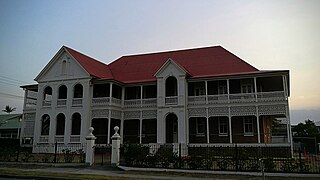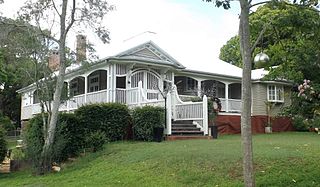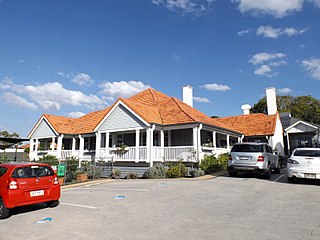
Oak Lodge and Spreydon is a heritage-listed pair of villas at 7 Warra Street & 30 Rome Street, Newtown, Toowoomba, Toowoomba Region, Queensland, Australia. They were designed by architectural firm James Marks and Son and was built from 1890s to c. 1923. They were added to the Queensland Heritage Register on 1 October 2003.

Rodway is a heritage-listed villa at 2 South Street, Rangeville, Toowoomba, Toowoomba Region, Queensland, Australia. The architect was Harry Marks. It was built from c. 1904 to 1930s. It is also known as Sylvia Park. It was added to the Queensland Heritage Register on 21 October 1992.

Weetwood is a heritage-listed Georgian style villa at 427 Tor Street, Newtown, Toowoomba, Toowoomba Region, Queensland, Australia. It was designed by architect James Marks and built from 1888 onwards. It was added to the Queensland Heritage Register on 21 October 1992.

Glengariff is a heritage-listed villa at 5 Derby Street, Hendra, City of Brisbane, Queensland, Australia. It was designed by Hubert George Octavius Thomas, with 1907 alterations by Robin Dods, and built from 1888 to 1889. It is also known as Dura and Glenaplin. It was added to the Queensland Heritage Register on 21 August 1992.

Nindooinbah Homestead is a heritage-listed homestead at Nindooinbah Connection Road, Nindooinbah, Scenic Rim Region, Queensland, Australia. It was built from c. 1858 to 1907. It is also known as Nindooinbah House. It was added to the Queensland Heritage Register on 21 October 1992.

Turrawan is a heritage-listed detached house at 8 London Road, Clayfield, Brisbane, Queensland, Australia. It was designed by Robin Dods and built from 1906 onwards. It is also known as Turrawan Private Hospital and Clayfield House. It was added to the Queensland Heritage Register on 24 September 2004.
The Residence at 41 Abbott Street is a heritage-listed detached house in New Farm, City of Brisbane, Queensland, Australia. It was designed by Robin Dods and built in 1900. It is also known as Hart Residence and Narallen. It was added to the Queensland Heritage Register on 28 April 2000.

Shafston House is a heritage-listed villa at 23 Castlebar Street, Kangaroo Point, Queensland, Australia. It was designed by Robin Dods and built from 1851 to 1930s. It is also known as Anzac Hostel, Ravenscott, and Shafston International College. It was added to the Queensland Heritage Register on 7 February 2005.

Mount Carmel Convent is a heritage-listed former Roman Catholic convent at 199 Bay Terrace, Wynnum, City of Brisbane, Queensland, Australia. It was designed by Hall & Dods and built in 1915 by William Richard Juster. It was added to the Queensland Heritage Register on 27 August 1999.

Weemalla is a heritage-listed detached house at 62 Ruthven Street, Corinda, City of Brisbane, Queensland, Australia. It was designed by Robin Dods and built from 1908 to 1909 by Hall and Mayer. It is also known as Steele House. It was added to the Queensland Heritage Register on 9 August 2013.

Cremorne is a heritage-listed villa at 34 Mullens Street, Hamilton, City of Brisbane, Queensland, Australia. It was designed by Eaton & Bates and built from 1905 to 1906. It was added to the Queensland Heritage Register on 21 October 1992.

The Royal Brisbane Hospital Nurses' Homes are heritage-listed accommodation for nurses at the Royal Brisbane Hospital, Herston Road, Herston, City of Brisbane, Queensland, Australia. It was built from 1896 to 1939. It includes the Lady Lamington Nurses' Home and Nurses' Homes Blocks 1 & 2. It was added to the Queensland Heritage Register on 21 October 1992.

Lyndhurst is a heritage-listed villa at 3 London Road, Clayfield, City of Brisbane, Queensland, Australia. It was designed by Robin Dods and built from 1896 onwards by Walls & Juster. It is also known as The Reid House. It was added to the Queensland Heritage Register on 12 December 2003.

Espie Dods House is a heritage-listed detached house at 97 Wickham Terrace, Spring Hill, City of Brisbane, Queensland, Australia. It was designed by architect Robin Dods for his brother Espie Dods and was built c. 1906. It is also known as "Ritas at Dods House Restaurant" and "i Central". It was added to the Queensland Heritage Register on 21 October 1992.

Lonsdale House is a heritage-listed detached house at 283 Boundary Street, Spring Hill, City of Brisbane, Queensland, Australia. It was built from 1860s circa to 1950s circa. It was added to the Queensland Heritage Register on 27 August 1999.

Victoria Flats is a heritage-listed apartment block at 369 Gregory Terrace, Spring Hill, City of Brisbane, Queensland, Australia. It was designed by architect Thomas Blair Moncrieff Wightman and built c. 1922 by Cheesman & Bull. It is also known as Kilroe's Flats and Morella, Carinyah, Lumtah and Neerim. It was added to the Queensland Heritage Register on 30 March 2001.

The William Berry residence is a heritage-listed detached house at 1 Burnett Street, West Ipswich, City of Ipswich, Queensland, Australia. It was built c. 1874. It is also known as William Berry residence. It was added to the Queensland Heritage Register on 21 October 1992.

Aldborough is a heritage-listed villa at 25 Deane Street, Charters Towers City, Charters Towers, Charters Towers Region, Queensland, Australia. It was designed by William Henry Allan Munro and built in 1900 by Thomas Barry O'Meara. It was added to the Queensland Heritage Register on 14 August 2008.

Myendetta Homestead is a heritage-listed homestead at Myendetta Station, Bakers Bend, Shire of Murweh, Queensland, Australia. It was designed by Robin Dods and built by Gibbs Brothers of Charleville. It was added to the Queensland Heritage Register on 2 December 2013.

Feniton is a heritage-listed villa at 388 Bowen Terrace, New Farm, City of Brisbane, Queensland, Australia. It was designed by Robin Dods and built from 1906 to 1907. It is also known as Almaden. It was added to the Queensland Heritage Register on 27 July 2018.






















